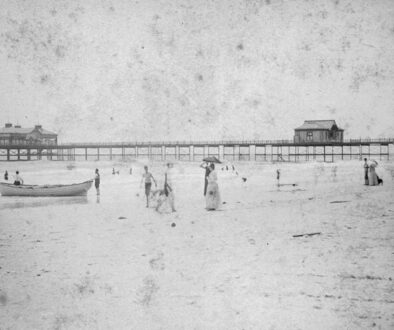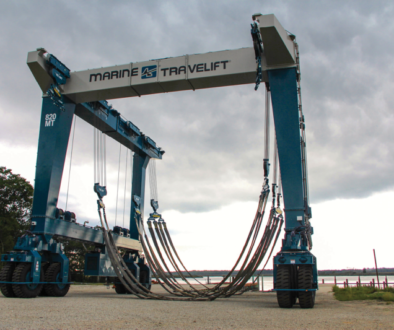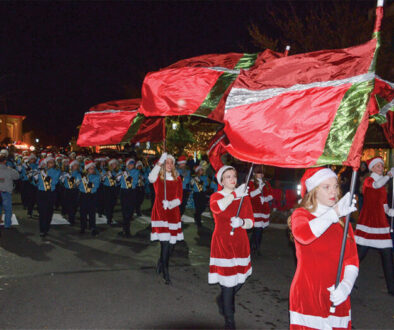Cape May As I Remember It: Part Six
The serialized recollections of a Cape May lifer.
The Colonial Hotel, Congress Hall, and the Chalfonte Hotel are three of the oldest structures in the city. The Colonial Hotel [now the Inn of Cape May] was owned and operated by the Fite family before it was sold several years ago. They had bath houses on the beach side of the hotel but those were demolished.
There was a very interesting article about the Chalfonte Hotel in Cape May Magazine several years ago. The article gave the history of the hotel from the Civil War to date. Congress Hall weathered a number of storms as it is so close to the ocean. One storm in particular removed a section of the roof that had been held up by tall pillars in the front of the building. The storm turned the roof over and deposited it on the front lawns of the houses on Congress Place. Since then, the hotel has been restored and is operating fully today.

The Columbia Laundry was located on Congress Street near North Street. It was destroyed by fire in the 1950s, and the land has never been developed. I was a volunteer fireman then, and I rode to the fire scene on an old GMC ladder truck. The tires on the truck were solid rubber, which made for a bumpy ride.
Dick Kelly had a garage at 484 West Perry Street, which is now the West End Garage retail shops. He subsequently moved from this location to Jefferson Street, where Cape May Day Spa and Wanderlust are now located. He and my dad were friends. He was at our house many times with his wife, Daisy.
Several years ago, Cape May was struck by what I would call a miniature tornado. The storm came in from the ocean, and demolished a bath house located on the boardwalk near Grant Street. It then jumped, and landed between the Hotel Alcott and the house behind it, tearing shingles from the house. It jumped again and landed at the 100 block of North Street. There were at least four very large sycamore trees in this block, and all were destroyed by the wind. The path of the storm took it to the 400 block of Myrtle Avenue, West Cape May, where a single home was completely destroyed. Its final landing was the electric company installation on Venice Avenue. The electric power went out in the entire town. The electric company brought a trailer to the installation, and had power restored in a matter of hours.
When I joined the Cape May Volunteer Fire Department, they only had four trucks, or apparatus, as the fire department called them. There was the 1928 LaFrance, which is in the museum today; an old Peter Pirsch that carried 500 gallons of water; a GMC truck that carried hose, and a GMC ladder truck. There was a Model-T ladder truck that was too old to be in service and was useless. (This was the apparatus that I mentioned in the Macomber fire story that no one would climb.) Our gear was a raincoat purchased at Frymire’s, a clothing store located at Jackson and Washington Streets, for $10.00. No breathing mask, no helmet and no job training. Our meeting room was in an old wooden two-story structure, where you could see your breath on a cold winter night. That’s the way it was in those days, but we had a department of over 40 volunteer members who were—as they are today—very dedicated to the responsibility of the safety of citizens and property in the city of Cape May.
Today, the Fire Department is much better equipped, better trained, and has more responsibility than ever before. I think I can safely say that the surrounding fire companies—West Cape May, Cape May Point, Town Bank, Erma, and Villas—are also better trained, better equipped, and ready for any fire or other emergency that may arise. We are fortunate that the fire department at the Coast Guard base responds to all fire calls in Cape May. too They are available on a moment’s notice. There is a mutual aid agreement within the fire companies in the area to respond to any emergency in another town, if requested. I know that you appreciate what the fire departments and ambulance services do not only for fires, but floods, motor vehicle accidents, and all emergencies.

There were a number of people in Cape May when I grew up that I can remember, as I am sure many others will. There was Dr. Franklin Hughes, who delivered babies at your home because there were no hospitals in the immediate area. (I was one of those babies.) Office visits were $2.00 with no appointment necessary. We couldn’t make an appointment anyway, because we did not have a telephone. Jake and Howard Tenenbaum had a haberdashery at 414 Washington Street. You could go to their store and just chat without having to buy anything. Alex Lyle from Commercial Garage, who would show me the new cars in detail, knowing I wouldn’t and couldn’t purchase a new vehicle. Alex was the perennial parade marshal and he really enjoyed it. John McDuell from McDuell’s Garage would let me repair my car there, and use his tools with no charge. Cold Spring Dock would let us kids fish and sometimes swim from the dock with no complaints. Charles (Nick) Swain, who was scoutmaster of BSA Troop 84, was good for us kids, as he taught us the scout law, which I believe made us better citizens. Who else would leave his business in the middle of summer and take the entire Boy and Cub Scouts to summer camp for an entire week? Steve Steger from Cape May High School coached football, basketball, baseball and track with no assistant coaches. In addition, he taught health classes and physical education. I remember him giving us a pep talk before a football game as only he could do. He had the knack of getting the best out of a person, no matter what.
In the 1930s many families did not have refrigerators. Blocks of ice were put inside of an insulated box to keep the inside cool enough for food. In Cape May, block ice was delivered by the Cape May Coal and Ice Company to homes and businesses. The driver—or ice man, as we called him—was Lou Dickinson. He had to chip the large blocks of ice into smaller blocks in order to fit the ice into the customer’s ice box. We kids would eat the small ice chips from the back of the truck with Mr. Dickinson’s permission.
There was another man, Mike McPherson, from Lower Township, who had a meat truck. He may have sold a variety of meat to local customers, but I only remember Mr. McPherson slicing lunch meat. He usually had a slice of baloney available to sample if we asked him.
There were several dairy farms in Lower Township and I can remember Frank Schellenger delivering whole milk to our home in a glass quart bottle. On cold winter mornings, the milk would expand, raising the milk from the bottle and pushing the cap up with it.
One man I can remember in the 1930s was the knife and scissor grinder man. He would come through the area each summer wearing a tripod on his back with an emery wheel on it. As he was walking along, he carried a bell in his hand that he would shake. The sound from the bell would alert homemakers in the immediate area that he was arriving. He was always welcome because knife and scissor blades were made of steel in those days, and required regular sharpening. There was a fee for this service. The man who came to our area had a monkey on his shoulder wearing a small cap. Children enjoyed watching the man work and especially liked the monkey.
Over the past several years a number of people who lived in Cape May for many years have passed away. With them go their memories of Cape May that have never been recorded. These have been some of mine, and I hope you have found it interesting.



